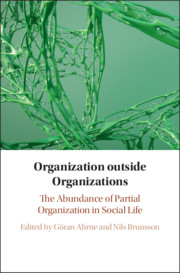Book contents
- Organization outside Organizations
- Organization outside Organizations
- Copyright page
- Contents
- Preface
- Contributors
- Introduction
- Part 1 Rules, Sanctions, Membership
- Part 2 Organization in and around Markets
- Part 3 Networks and Other Social Relationships
- Part 4 Social Movements and Collective Action
- Part 5 The Partial Organization of Formal Organizations
- Conclusion
- Index
- References
Part 2 - Organization in and around Markets
Published online by Cambridge University Press: 11 July 2019
- Organization outside Organizations
- Organization outside Organizations
- Copyright page
- Contents
- Preface
- Contributors
- Introduction
- Part 1 Rules, Sanctions, Membership
- Part 2 Organization in and around Markets
- Part 3 Networks and Other Social Relationships
- Part 4 Social Movements and Collective Action
- Part 5 The Partial Organization of Formal Organizations
- Conclusion
- Index
- References
Summary
Markets and organizations are often contrasted with each other and are sometimes even treated as opposites. But they share at least one characteristic: They are both organized. Many markets have been created by organization, and virtually all markets are organized to a greater or lesser extent; for markets to function according to the normative ideals of economists, a high degree of organization is necessary. In this chapter, the organization of markets is contrasted to other ways by which markets are formed – mutual adaptation among sellers and buyers and institutions. Organization adds substantially to the uncertainty that has been seen as a typical trait of markets. The chapter describes how different combinations of organizational elements are used in different markets. In addition to sellers and buyers, there are two types of market organizers: ‘profiteers’, who organize in order to benefit their own business; and ‘others’, who claim that they organize for the benefit of other people or of everyone. Market organization is the basis for a form of democracy on the global level – a form other than that tied to a formal organization, such as a state.
Keywords
- Type
- Chapter
- Information
- Organization outside OrganizationsThe Abundance of Partial Organization in Social Life, pp. 113 - 188Publisher: Cambridge University PressPrint publication year: 2019



